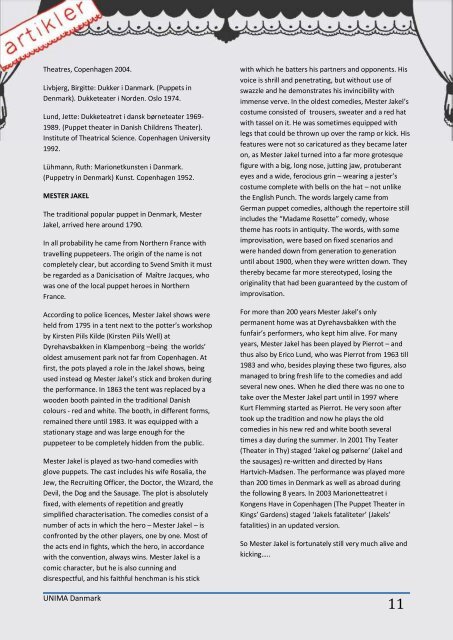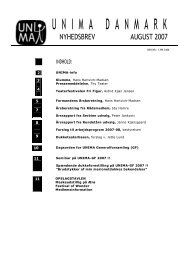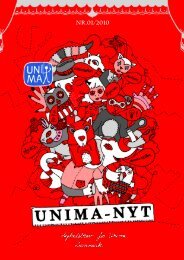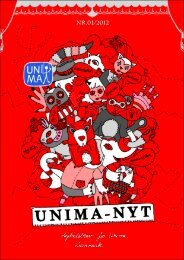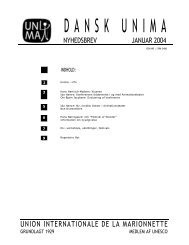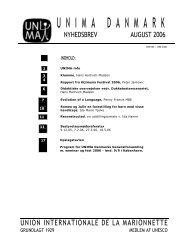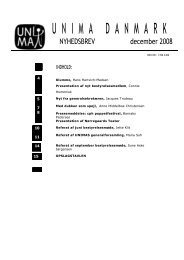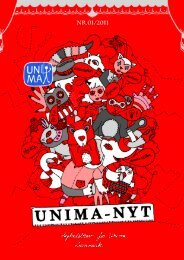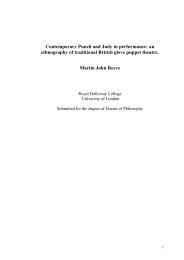UNIMA-NYT
UNIMA-NYT - UNIMA Danmark
UNIMA-NYT - UNIMA Danmark
- No tags were found...
Create successful ePaper yourself
Turn your PDF publications into a flip-book with our unique Google optimized e-Paper software.
Theatres, Copenhagen 2004.Livbjerg, Birgitte: Dukker i Danmark. (Puppets inDenmark). Dukketeater i Norden. Oslo 1974.Lund, Jette: Dukketeatret i dansk børneteater 1969-1989. (Puppet theater in Danish Childrens Theater).Institute of Theatrical Science. Copenhagen University1992.Lühmann, Ruth: Marionetkunsten i Danmark.(Puppetry in Denmark) Kunst. Copenhagen 1952.MESTER JAKELThe traditional popular puppet in Denmark, MesterJakel, arrived here around 1790.In all probability he came from Northern France withtravelling puppeteers. The origin of the name is notcompletely clear, but according to Svend Smith it mustbe regarded as a Danicisation of Maître Jacques, whowas one of the local puppet heroes in NorthernFrance.According to police licences, Mester Jakel shows wereheld from 1795 in a tent next to the potter’s workshopby Kirsten Piils Kilde (Kirsten Piils Well) atDyrehavsbakken in Klampenborg –being the worlds’oldest amusement park not far from Copenhagen. Atfirst, the pots played a role in the Jakel shows, beingused instead og Mester Jakel’s stick and broken duringthe performance. In 1863 the tent was replaced by awooden booth painted in the traditional Danishcolours - red and white. The booth, in different forms,remained there until 1983. It was equipped with astationary stage and was large enough for thepuppeteer to be completely hidden from the public.Mester Jakel is played as two-hand comedies withglove puppets. The cast includes his wife Rosalia, theJew, the Recruiting Officer, the Doctor, the Wizard, theDevil, the Dog and the Sausage. The plot is absolutelyfixed, with elements of repetition and greatlysimplified characterisation. The comedies consist of anumber of acts in which the hero – Mester Jakel – isconfronted by the other players, one by one. Most ofthe acts end in fights, which the hero, in accordancewith the convention, always wins. Mester Jakel is acomic character, but he is also cunning anddisrespectful, and his faithful henchman is his stick<strong>UNIMA</strong> Danmarkwith which he batters his partners and opponents. Hisvoice is shrill and penetrating, but without use ofswazzle and he demonstrates his invincibility withimmense verve. In the oldest comedies, Mester Jakel’scostume consisted of trousers, sweater and a red hatwith tassel on it. He was sometimes equipped withlegs that could be thrown up over the ramp or kick. Hisfeatures were not so caricatured as they became lateron, as Mester Jakel turned into a far more grotesquefigure with a big, long nose, jutting jaw, protuberanteyes and a wide, ferocious grin – wearing a jester’scostume complete with bells on the hat – not unlikethe English Punch. The words largely came fromGerman puppet comedies, although the repertoire stillincludes the “Madame Rosette” comedy, whosetheme has roots in antiquity. The words, with someimprovisation, were based on fixed scenarios andwere handed down from generation to generationuntil about 1900, when they were written down. Theythereby became far more stereotyped, losing theoriginality that had been guaranteed by the custom ofimprovisation.For more than 200 years Mester Jakel’s onlypermanent home was at Dyrehavsbakken with thefunfair’s performers, who kept him alive. For manyyears, Mester Jakel has been played by Pierrot – andthus also by Erico Lund, who was Pierrot from 1963 till1983 and who, besides playing these two figures, alsomanaged to bring fresh life to the comedies and addseveral new ones. When he died there was no one totake over the Mester Jakel part until in 1997 whereKurt Flemming started as Pierrot. He very soon aftertook up the tradition and now he plays the oldcomedies in his new red and white booth severaltimes a day during the summer. In 2001 Thy Teater(Theater in Thy) staged ‘Jakel og pølserne’ (Jakel andthe sausages) re-written and directed by HansHartvich-Madsen. The performance was played morethan 200 times in Denmark as well as abroad duringthe following 8 years. In 2003 Marionetteatret iKongens Have in Copenhagen (The Puppet Theater inKings’ Gardens) staged ‘Jakels fataliteter’ (Jakels’fatalities) in an updated version.So Mester Jakel is fortunately still very much alive andkicking…..11


